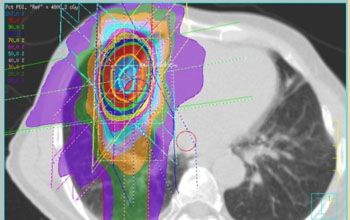SBRT Improves NSCLC Survival Rates in Elderly Patients
By MedImaging International staff writers
Posted on 14 Oct 2016
Survival rates of elderly patients with early-stage non-small cell lung cancer (NSCLC) have risen dramatically over the past decade, concurrent with the increasing adoption of stereotactic body radiation therapy (SBRT), according to a new study.Posted on 14 Oct 2016
Researchers at Houston Methodist Hospital (HMH; Houston, TX, USA), Baylor College of Medicine (Houston, TX, USA), and other institutions reviewed the medical records of 62,213 patients age 60 and above who were diagnosed with stage I NSCLC between 2004 and 2012, as extracted from the U.S. Surveillance, Epidemiology, and End Results (SEER) database. The patients were grouped into five-year subsets (60-64; 65-69; 70-74; 75-79; 80-84; 85-89; and 90 and older), and overall survival (OS) and lung cancer-specific survival rates were then calculated to draw population-based comparisons between SBRT and surgery alone.

Image: An example of dose distribution of SBRT for lung cancer (Photo courtesy of the NIH).
The results showed that from 2004 to 2012--the years in which adoption of SBRT in community practice became widespread--the OS rate at 23 months following SBRT alone rose from 39 to 58%; OS rates for surgery alone rose from 79 to 84%. In the same time period, cancer-specific survival increased from 48 to 72% of patients who received SBRT alone, and from 87 to 91% of patients receiving surgery alone. Cancer-specific survival rates remained stable for patients who received neither surgery nor radiation.
Analysis revealed that the use of surgery to treat stage I NSCLC declined with age. While 81% of patients age 60-64 underwent surgery, only 47% of patients age 80 or older were able to undergo surgery. The use of SBRT, conversely, rose with increasing age, ranging from 11% of patients age 60-64 to 39% of patients age 90 or above. The number of patients receiving no treatment also increased, from 7 to 40% for the youngest and oldest elderly patient cohorts in the study. The study was presented at the 58th annual meeting of the American Society for Radiation Oncology (ASTRO), held during September 2016 in Boston (MA, USA).
“While survival rates remain highest for surgical candidates, this study demonstrates both clear benefits from SBRT for nonsurgical NSCLC patients and that outcomes following radiation therapy have improved at a more accelerated pace over the past decade than those for any other therapeutic approach,” said senior author Andrew M. Farach, MD, of Baylor College of Medicine. “With continued adoption of SBRT in community cancer centers, it is our hope that more patients will receive curative SBRT and the number of patients left untreated based on age or medical comorbidity will continue to fall.”
SBRT is emerging as an attractive option for treating cancers in the lung, head and neck, prostate, liver and other disease sites, with the objective of increasing local control of the target lesion while limiting dose to nearby critical structures and normal tissue. Requirements include precise localization of the target lesion in the treatment planning process; accounting for tumor motion due to respiration or other changes in the body; highly conformal dose distribution to the target volume, including a steep dose gradient to minimize radiation to surrounding healthy tissue; and image-guidance at the time of dose delivery for verification and adjustment of the target localization.
Related Links:
Houston Methodist Hospital
Baylor College of Medicine














